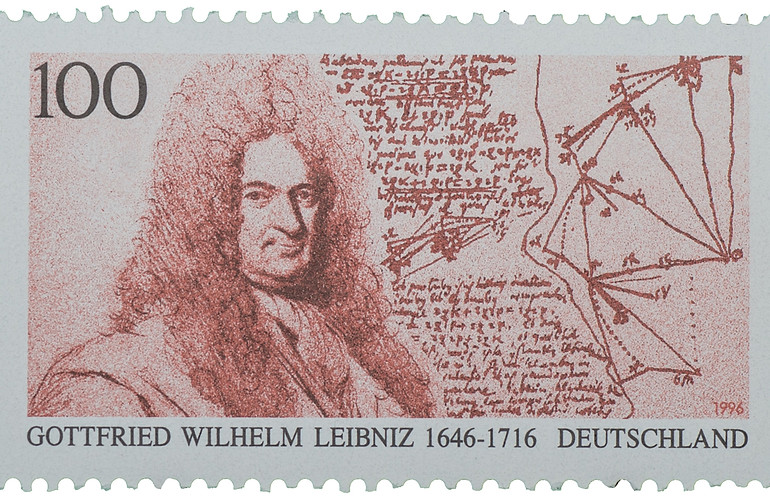The Most Influential
People in History

Gottfried Wilhelm Leibniz / LIEB-nihtz /
1646–1716
German Mathematician and Philosopher
Mathematics Ranking 14th of 46

Leibniz on a German stamp from 1996.
Gottfried Wilhelm Leibniz spent his life in the diplomatic and political service, and in 1700 was appointed first president of the Academy of Sciences in Berlin. Leibniz devised a method of calculus independent of Newton. In terms of influence, Leibniz published his discovery in 1684, twenty years before Newton. Most importantly, the Bernoulli brothers, followers of Leibniz, were the major force in spreading and promoting calculus throughout Europe. Secondly, continental Europe adopted Leibniz's more efficient differential notation, dy/dx over Newton's dot notation, /x = 2x“Often described as a universal genius, Leibniz mastered a bewildering array of scholarly subjects and left his mark upon each.”(1)
Early Years
Leibniz began as a child prodigy with access to the sizable library of his father, a professor of moral philosophy. Gottfried made the most of this opportunity, teaching himself Latin and Greek at an early age and reading the books on his father’s shelves so voraciously that he was ready to enter the University of Leipzig at the age of 15. He rapidly completed his university education, and by 20 had completed his doctoral dissertation. Although on the brink of a promising academic career, Leibniz left the university to work for the Elector of Mainz, a potentate of one of the many small states into which Germany was then divided. In 1672, at age 26, he was sent from Germany to Paris as a high-level diplomat. Leibniz made the most of the intellectual life of the French capital, and side trips to London and Holland brought the young genius into contact with such established scholars as Robert Hooke, Robert Boyle, Antoni van Leeuwenhoek, and the philosopher Baruch Spinoza. The Dutch scientist Christiaan Huygens (1629–1695) was also living in Paris under a pension from Louis XIV. He provided Leibniz with valuable advice that strengthened his mathematical training. By the time Leibniz had left Paris in 1676, he had discovered for himself the fundamental principles of calculus. “His four years in Paris had seen him rise from mathematical novice to mathematical giant.”(2)
Mathematics–Calculus
In 1684, Leibniz published his discoveries about calculus in a paper with the lengthy title “A New Method for Maxima and Minima, as well as Tangents, which is neither impeded by fractional nor irrational Quantities, and a remarkable Type of Calculus for them.” Thus the world learned the calculus from Leibniz and not from Newton. Indeed, it was from the title of this paper that the subject took its name. Newton and his fellow English asserted, with varying degrees of tact, that Leibniz had plagiarized the whole thing. Leibniz’s visit to England, his familiarity with the quietly circulating Newtonian manuscript, his exchange of letters—all convinced British partisans that Leibniz had stolen Newton’s glory. “Leibniz freely admitted his contact with Newtonian ideas through letters and manuscripts, but observed that these had given him only hints at results, not clear-cut methods; these methods Leibniz discovered for himself.”(3)
Recall that Newton had written his first tract on calculus in 1666, almost two decades before Leibniz’s paper was published; yet it was not until 1704 that Newton published a specific account of his method in the appendix to his Opticks. The symbols which are still used today in differential and integral calculus derive mainly from Leibniz, who was also the first to realize the importance of the new calculating methods to the entire field of mathematics.(4)
In any comparison of the two great inventors of the calculus, one fact stands out. Newton, to the end of his life, remained solitary, never surrounding himself with a group of gifted disciples, eager to learn, refine, and extend his work. By contrast, it was Leibniz’s good fortune that two of his most enthusiastic followers were Jakob and Johann Bernoulli of Switzerland, brothers who would become the major force in disseminating and promoting the calculus throughout Europe. Their efforts, perhaps as much as those of Leibniz himself, gave the subject the flavor and appearance that it retains to this day.(5)
Mathematics–Logic
“Leibniz made the important distinction between necessary (logical) truths and contingent (factual) truths, and proposed a universal logical language which would eliminate ambiguity.”(6) His attempts constituted the first real step toward what we today call “symbolic logic.” In particular, his use of algebraic formulas to denote logical statements was a significant advance beyond the verbal syllogisms of Aristotle’s logical theory.
Later Years
In 1700, Leibniz was a major force in the creation of the Berlin Academy.(7) This community of scholars, writers, and musicians was intended to bring to Berlin the greatest thinkers in Europe and thereby put that city on the intellectual map. Leibniz was honored by being named the Academy’s president, a position he held for the rest of his life. However, by 1716, when Leibniz died, his status had diminished, and reports are that only a trusted servant attended the funeral of this great man. This stands in stark contrast to Newton’s titanic reputation in England that led to his burial in the honored shrine of Westminster Abbey.
Footnotes:
(1) William Dunham, Journey Through Genius - The Great Theorems of Mathematics (New York, 1990), p. 184.
(2) Ibid., p. 187.
(3) Ibid., p. 188.
(4) Jan Gullberg, Mathematics – From the Birth of Numbers (New York, 1997), p. 679.
(5) Dunham, p. 190.
(6) Judy Pearsall abd Bill Trumble (editors), The Oxford Encyclopedic English Dictionary (New York, 1996), p. 818.
(7) Dunham, p. 190.
1